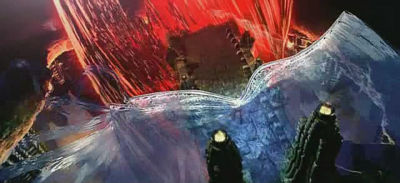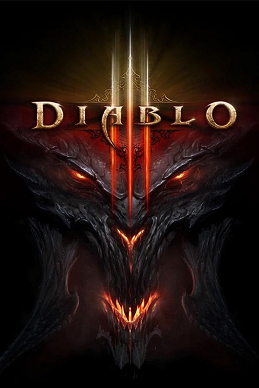In the current case, "the other day" was some months ago, but don't let that keep you from reading on. I anticipated Diablo III for quite some time, although not as much as I waited for Starcraft II. Taking part in the Open Beta, I was sceptical, but then again, it was Blizzard, and they never published anything remotely bad. So, when my copy of Diablo III arrived, I started playing, finished the first run-through quickly in Single Player so I could experience the storyline (not really possible when playing multiplayer since someone always wants to race along) and then quickly paced through the other difficulty levels with friends. When my Barbarian Shagga, Son of Dolf, reached Level 60 and I entered "Inferno"-Difficulty, I finally understood what kind of game Blizzard had made with "Diablo III" and how mistaken I had been.
 |
| Look at my works, ye mighty, and despair! |
Inferno difficulty deserved its name. It was difficult as hell, and I was dying all the time and got increasingly frustrated by the experience. I quickly learned that to play on Inferno, I had to master the game like I once tried to master Starcraft II - meaning, on a competitive level. Quick clicks, changing skills, strafing enemy fire, all that stuff. And I felt absurdely cheated, because I didn't sign up for that. What I wanted was a game in which I could log in, slay my way through the Frigid Highlands, level up a bit and feel satisfied for the day. A bit mindless clicking just for the fun of it. I certainly didn`t want to get a serious challenge out of it; this was Diablo, after all. Now, this isn't Blizzard's fault; it's my problem that my expectations didn't meet up with the product, and perhaps I should have researched it better. Since then, Diablo III collects dust on my shelf. It's not a bad game in any sense, it's just one I didn't want to play. There was another thing besides the gameplay, however, that really pissed me off.
 |
| Responsible: that guy, among others. |
And this element was the story. The whole story of Diablo III is breathtakingly bad. I was accustomed to a new low of storytelling by Blizzard since Starcraft II came out (more on that in a later post). And Blizzard did a good job at this in the past. To paint the stark contrast, let's shortly rehash the story of Diablo II and, before we do, please keep all in mind that we're not talking about Shakespeare in either game. Storytelling in video games continues to stay way below the opportunities,
as I argued earlier. That being said, Diablo II. The game starts with a short rehash of Diablo I (evil demon below chathedral, slain by hero, said hero takes spirit of evil demon in his own body for unknown reasons) from the eyes of a guy named Marius, who lives his life in a sanitarium to drench his nightmares. The peace of the place is disturbed when The Wanderer(tm) enters the building, obviously fighting some evil presence, and a horde of demons is unleashed in the process, taking down the sanitarium. Marius survives and follows the Wanderer, who calls out for him. From there, they journey east to a desert city called Lut Gholein, where they seek out the grave of the arch-evil Baal, brother to Diablo, who was chained up there in a similar fashion to Diablo: the evil spirits are contained within soul stones, and a hapless guy needs to be the vessel for said stone, forever fighting the demon.
 |
| You might get suspicious at this point, Marius. |
The Wanderer(tm) then wants to remove the soulstone, but an archangel named Tyrael prevents him, fighting him. Marius is seduced by Baal's evil voice and takes out the stone himself, which frees Baal. In his remaining moments before being imprisoned himself, Tyrael tells Marius what has to happen now: the stones remain linked to the arch evils, and he needs to travel to the jungle city of...something...and enter the gates of hell there, because the stones can only finally be destroyed in the hell forge. At this point, you might guess what your job will be. Marius travels there, only to learn that he is too late: Baal and Diablo liberated their remaining brother, Mephisto, and Diablo goes directly into hell, taking command of the forces there to storm the heavens, and Marius chickens out and flees, still holding the soul stone. Much later he is sought out by Baal who kills him and retakes his soul stone, trys to corrupt the ominous "world stone" (essentially a McGuffin) and remains to be slain by a hero, while Tyrael destroys the corrupted world stone.
 |
| Which looked like a LSD dream and was about as coherently conveyed. |
Now, there is one reason why the story of Diablo II worked at least up to Act IV, the slaying of Diablo himself (the Baal story with the world stone came with the Add-on and already suffered problems): it was coherent in atmosphere and ambience and conducted through the eyes of a third party, Marius. Your player character is essentially a blank slate on which you can project anything, and the interaction with NPCs in the game itself can be considered as a joke. It's Diablo, after all, so click the enemies dead, bitch! (Imagine Aaron Paul delivering that line.) So, when the game starts, you find yourself in the aftermath of the first cutscene, the takeover of the sanctuarium. The natives of the regions, the rogues, are outnumbered heavily by the evils roaming the countryside. While you are outnumbered, too, you have access to healing potions and a never-tiring index finger. So you slay your way into the santuarium, learning that the Wanderer(tm) is responsible for all of it (you knew already, of course, but your character didn`t). Chasing him, you travel to Lut Gholein where, surprise, evils roam the countryside because something bad happened. You try to find out what exactly, finally finding the tomb of Baal, empty except for a boss monster and Tyrael who delivers his infodump.
 |
| Which, honest to god, is the only function of Mr. Badass Archangel in the whole game. |
So, journey to the jungle city, where evils roam the countryside. We have to prevent Mephisto from escaping! You as player can already deduce how this will go, of course, but the game creates a sense of urgency in the few lines of dialogue the NPCs have, provided you read them at all and don`t just slaughter through the fiends, which is perfectly acceptable behavior, too. Upon entering Mephisto's lair, you learn that he was already awakened, BUT at least he's still there. You kill him and take his soul stone before entering hell, where Tyrael informs you that you need to bring it to the forge of hell, a task in which Marius failed so spectacularly and to which he couldn't bring his lazy ass about performing. So, you slaughter through hell, destroy the soul stone, take on Diablo himself, kill him and destroy his soul stone, game ends.
 |
| Hadn't expected that to happen, bitch! (Imagine Aaron Paul again, if you would.) |
End of Part 1.







No comments:
Post a Comment